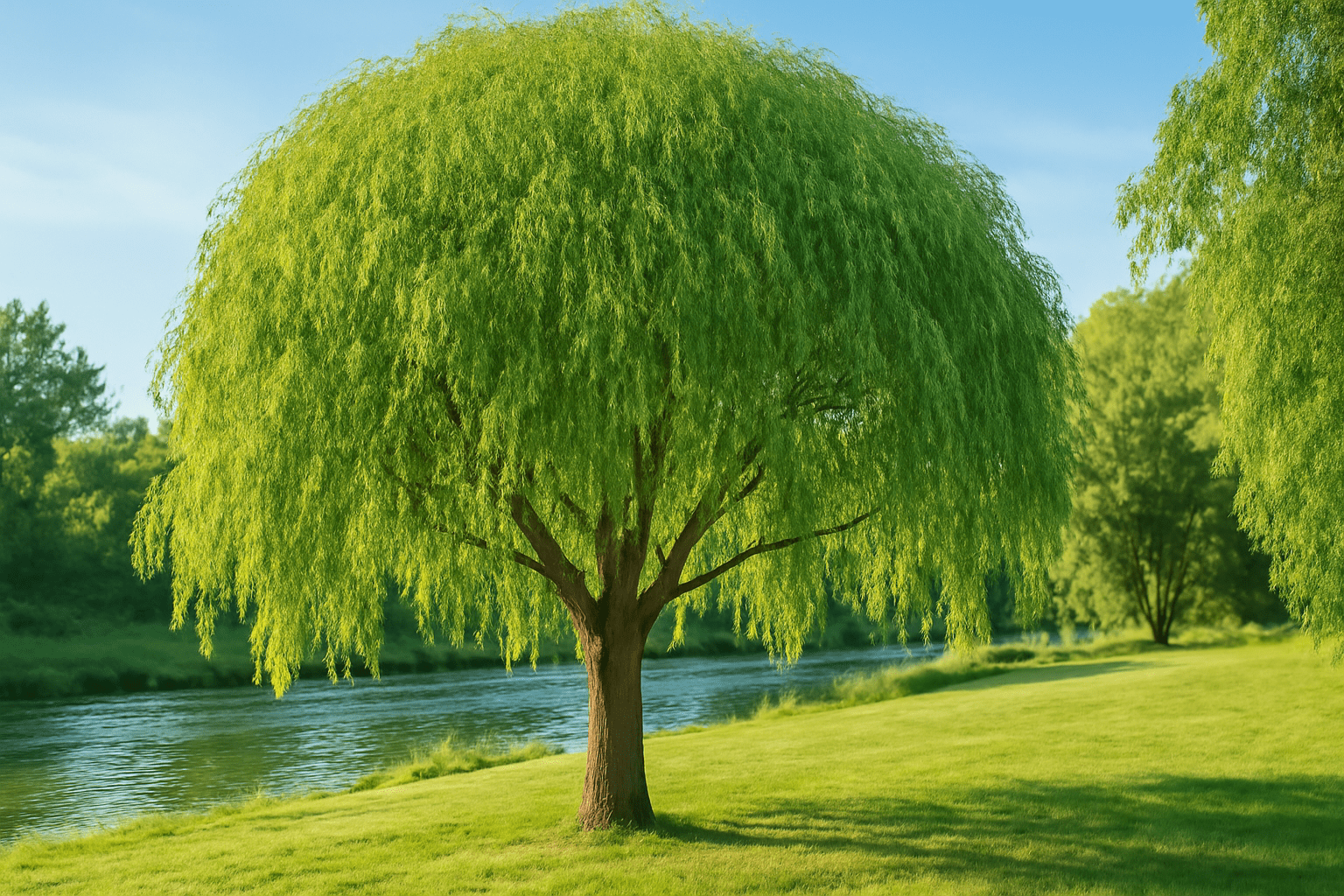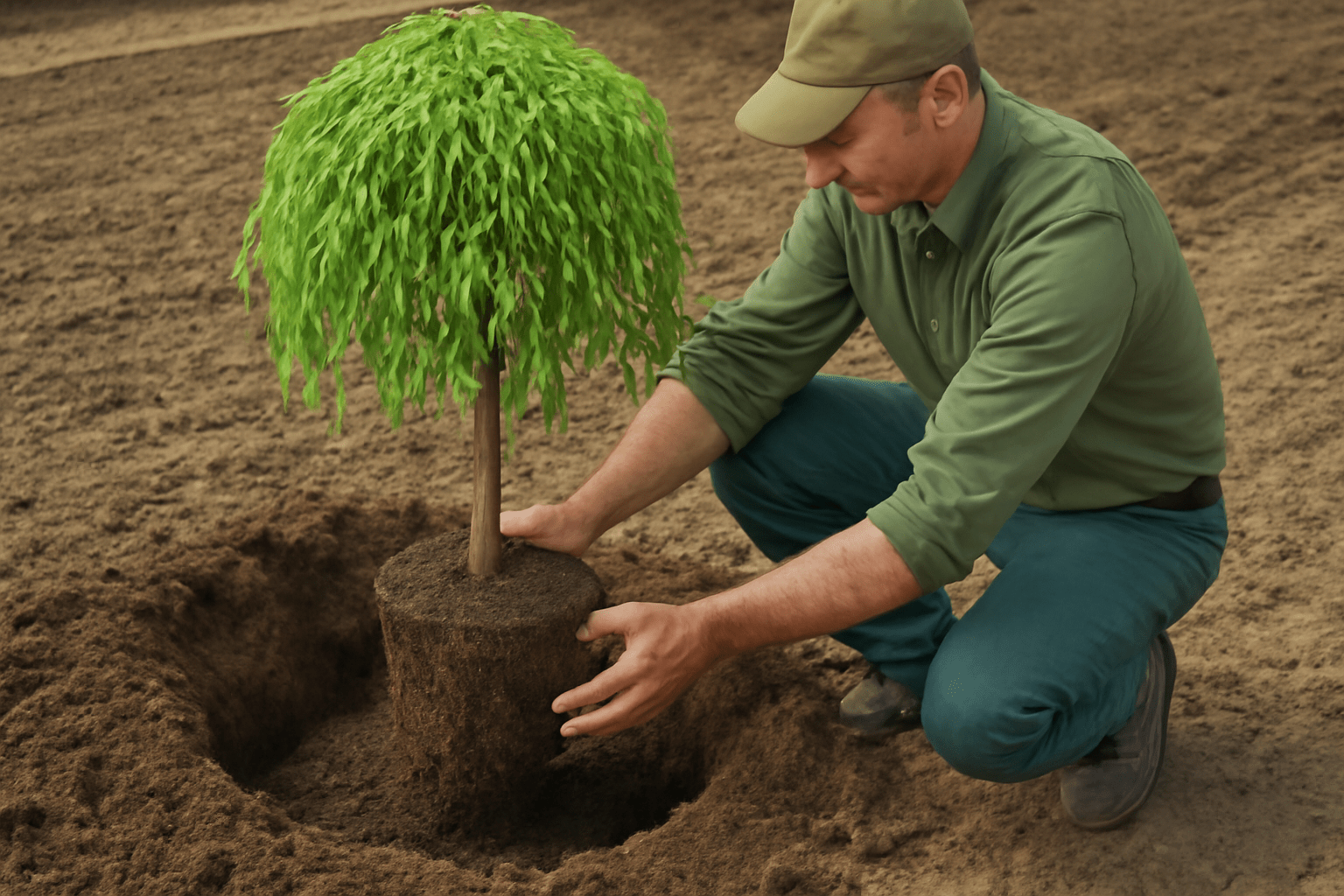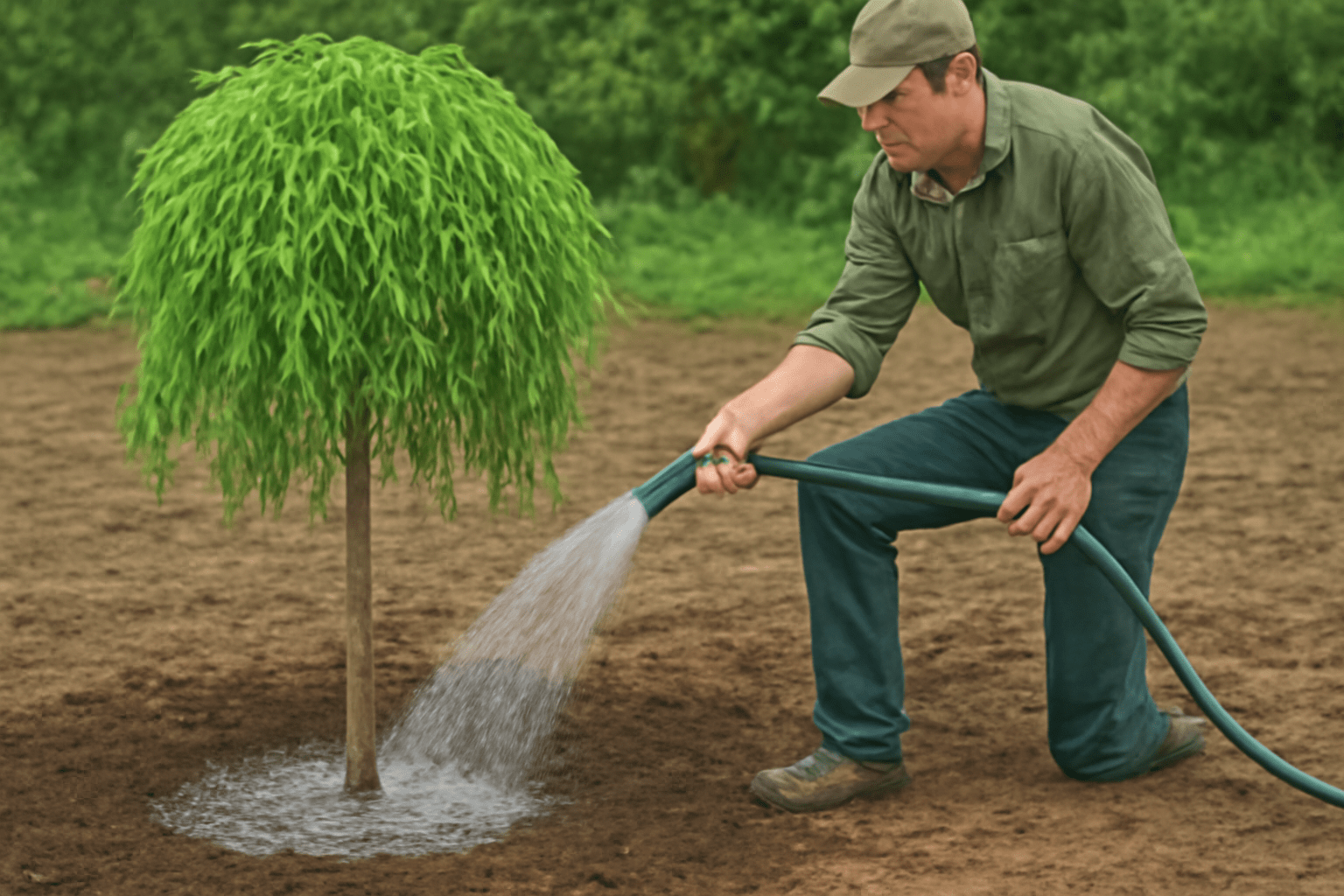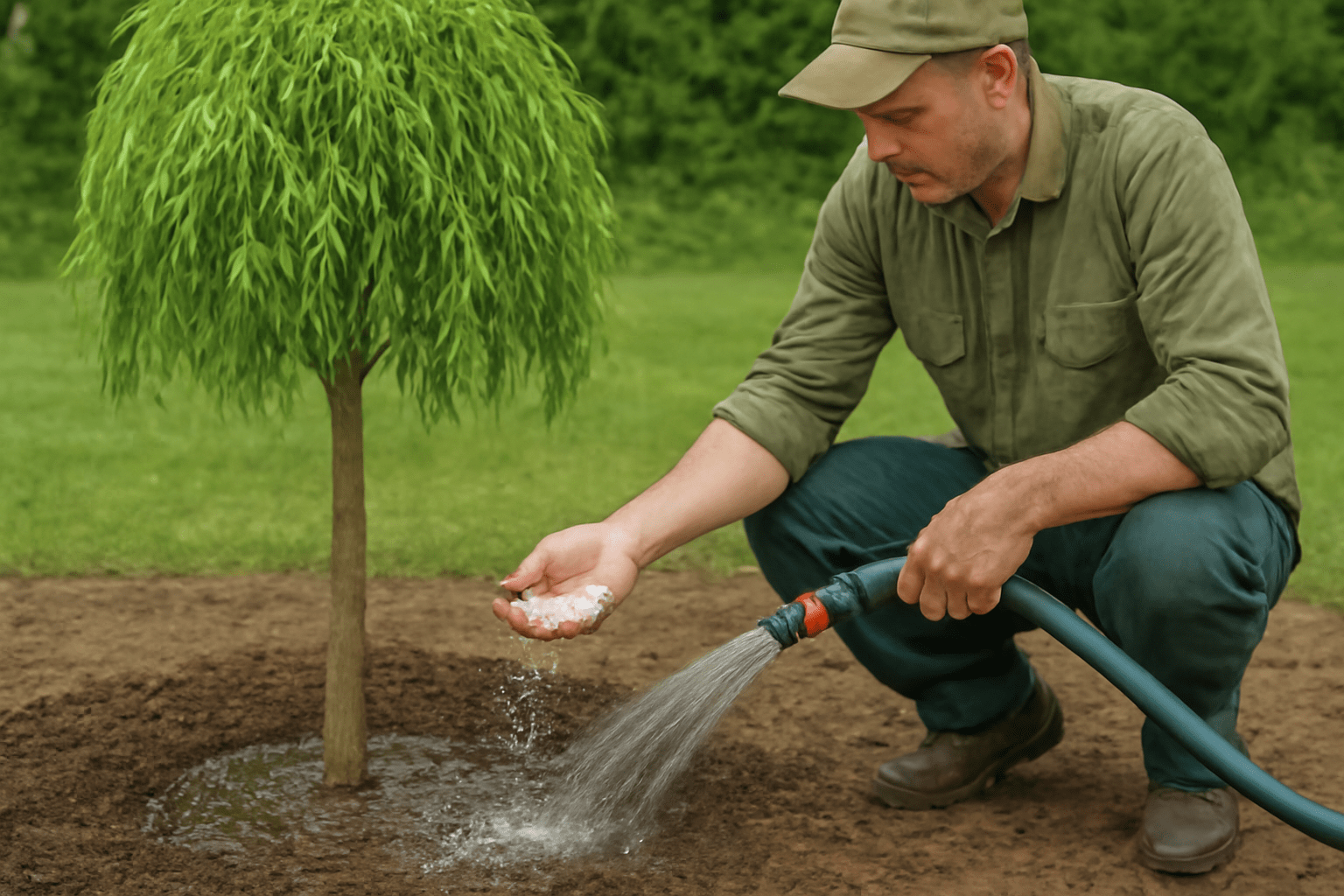
How to Care for a Globe Willow Tree: Expert Tips for Healthy Growth
The globe willow tree is a stunning addition to any landscape, known for its unique, rounded shape and vibrant green foliage. 
In this guide, we’ll provide expert tips on how to care for your globe willow tree, ensuring it thrives year after year. From selecting the perfect location to understanding its water and soil needs, we’ll cover everything you need to know to keep your tree healthy and beautiful. Keep reading to learn how to make the most of your globe willow tree and enjoy its beauty for years to come!
Table of Contents
ToggleWhat is a Globe Willow Tree?
A Globe Willow tree, also known as Salix matsudana ‘Navajo,’ is a unique and fast-growing species famous for its striking round canopy and graceful, weeping branches. This tree is an excellent choice for gardeners looking to add a touch of elegance to their landscapes, thanks to its distinctive globe-shaped crown and vibrant green foliage.
Native to China and Japan, the Globe Willow thrives in a variety of climates, making it adaptable to a wide range of soil conditions. Its ability to grow quickly—sometimes reaching heights of up to 40 feet—makes it a popular choice for creating shaded areas or privacy screens. However, despite its impressive growth rate, it’s not a low-maintenance tree. Proper care is essential to ensure it thrives in your garden for years to come.

These trees are also known for their resilience against pests and diseases, but they are sensitive to water stress, so ensuring they are properly watered, especially during dry spells, is crucial for maintaining their health. The Globe Willow’s root system, though extensive, is generally not invasive, making it a good option for planting near buildings or patios.
With the right care, a Globe Willow tree can become a beautiful focal point in your yard, offering both shade and aesthetic appeal.
Best Location for Planting a Globe Willow Tree 
Finding the right spot to plant your Globe Willow Tree is essential for its health and growth. Here’s how to choose the best location for your tree:
1. Sunlight 
Globe Willows thrive in full sun. Ensure that the area receives at least 6 hours of direct sunlight each day. Sunlight is key to promoting healthy growth and vibrant foliage. Avoid planting in shady areas, as the tree will not grow as vigorously in low-light conditions.
2. Soil Type 
Globe Willows prefer well-draining soil but are adaptable to a variety of soil types, including clay, loam, or sandy soil. Ensure the ground isn’t too compacted, as the roots need room to spread and breathe. If your soil is heavy or clay-like, consider amending it with organic matter to improve drainage.
3. Space for Growth 
These trees can grow quite large, reaching up to 30 feet in height and spreading up to 40 feet wide. Be sure to plant your Globe Willow far enough from buildings, fences, and other trees to allow it to reach its full potential. Aim for at least 10-15 feet of clearance from structures to avoid overcrowding and ensure good airflow around the tree.

4. Watering Needs 
Globe Willows love water and thrive near water sources. A location near a stream, pond, or well-irrigated area will suit them best. If planting away from natural water sources, be prepared to water your tree regularly, especially during dry spells. However, avoid areas that are prone to waterlogging, as the tree’s roots prefer well-drained soil.
5. Wind Protection 
While Globe Willows are fairly resilient, they can be vulnerable to strong winds due to their large, drooping branches. If you live in a windy area, consider planting your tree near a natural windbreak, such as a fence or other trees. This will help protect the tree and prevent breakage of its branches.
By following these tips and choosing the right location, your Globe Willow Tree will have the perfect environment to thrive and add beauty to your landscape for years to come.
Planting Your Globe Willow Tree 
Planting a globe willow tree in your garden is a rewarding experience that adds beauty and shade to your landscape. But to ensure it grows healthy and strong, proper planting techniques are essential. Here’s a step-by-step guide to help you get it right.
Choose the Right Location 
Globe willows thrive in full sunlight, so pick a spot in your yard that receives at least 6 hours of direct sunlight each day. These trees are tolerant of various soil types, but they do best in well-draining, slightly acidic to neutral soil. Avoid low-lying areas where water can pool, as excessive moisture can lead to root rot.
Dig the Perfect Hole 
Start by digging a hole that is about twice the size of the tree’s root ball. This gives the roots plenty of space to spread and grow. The hole should be no deeper than the root ball’s height—this helps avoid burying the tree too deeply, which can cause it to struggle.

Prepare the Tree for Planting 
Before placing your globe willow in the hole, gently remove it from the pot or container. If the roots are tightly wound, carefully loosen them to encourage outward growth. Take care not to damage the roots during this process.
Place the Tree and Fill the Hole 
Position the globe willow in the center of the hole, ensuring that the top of the root ball is level with or slightly above the surrounding soil. Backfill the hole with the soil you removed, pressing it down lightly as you go. This ensures there are no air pockets around the roots.
Water Thoroughly 
After planting, give your globe willow a deep watering to help settle the soil around the roots. Make sure the water reaches deep into the root zone to encourage strong root development. Keep the soil consistently moist for the first few weeks to help the tree establish itself.
Mulch for Protection 
Add a layer of mulch around the base of the tree, but keep it a few inches away from the trunk. Mulch helps retain moisture, suppress weeds, and regulate soil temperature. Just be careful not to overdo it—too much mulch can suffocate the roots.
By following these simple steps, you’ll set your globe willow tree up for success! With the right care and attention, it will grow into a beautiful, resilient tree that enhances your landscape for years to come.
This section is optimized to be beginner-friendly and SEO-friendly, answering common questions clearly and concisely while providing a practical, actionable guide for readers.
Watering and Irrigation for Globe Willow Trees 

Proper watering is key to ensuring your Globe Willow tree thrives. These trees, native to regions with seasonal rainfall, require a balanced approach to irrigation for optimal growth. Here’s how you can effectively water your Globe Willow:
1. Water Deeply, Not Frequently 
Globe Willow trees prefer deep watering rather than frequent shallow sprinklings. Water the tree thoroughly, allowing the moisture to reach the root zone. This encourages deeper root growth, making your tree more resilient to drought conditions in the long run. Aim to water deeply every 7-10 days, depending on the weather and soil conditions.

2. Monitor Soil Moisture 
Before watering, check the soil moisture. Stick your finger into the soil around the base of the tree. If it feels dry up to 2-3 inches deep, it’s time to water. If it’s still moist, wait another day or two. Overwatering can lead to root rot, so it’s crucial to avoid soggy soil.
3. Adjust for Seasonal Changes 

During the hot summer months, Globe Willows may need more water, especially if they’re young. In cooler seasons or after rainfall, reduce watering to prevent waterlogging. Always adjust based on the weather—hotter days and windy conditions can dry out the soil faster.
4. Consider Drip Irrigation 
A drip irrigation system is a fantastic choice for Globe Willows. It delivers water directly to the roots, ensuring efficiency and minimizing water waste. Drip irrigation also helps maintain consistent moisture levels, reducing the chances of overwatering or underwatering.
5. Mulch for Moisture Retention 
Adding a layer of mulch around the base of your Globe Willow tree can significantly help with moisture retention. Mulch prevents evaporation, keeps the soil cool, and reduces the need for frequent watering. Use organic mulch like wood chips or shredded bark and apply it around the tree, making sure it doesn’t touch the trunk directly.
6. Signs of Overwatering or Underwatering 
- Overwatering: Yellowing leaves, wilting, or soggy soil can indicate overwatering. If you notice any of these signs, check that the soil drains well and reduce watering frequency.
- Underwatering: Dry, brittle leaves or brown tips can be a sign your Globe Willow needs more water. Be sure to provide deep watering sessions when needed.
By following these simple watering tips, you’ll help your Globe Willow grow strong and healthy, providing a beautiful tree that thrives in its environment!
Fertilizing Your Globe Willow Tree 
Fertilizing your Globe Willow Tree is a key part of ensuring it grows strong, healthy, and vibrant. Proper fertilization helps provide the essential nutrients your tree needs to thrive. Here’s a straightforward guide to keep your Globe Willow in top shape:
1. Choose the Right Fertilizer 
Select a balanced, slow-release fertilizer with equal amounts of nitrogen (N), phosphorus (P), and potassium (K). Look for fertilizers labeled as “NPK 10-10-10” or something similar. This ensures that your tree gets all the nutrients it needs for healthy foliage, roots, and overall growth.
2. When to Fertilize 
The best time to fertilize your Globe Willow Tree is in the spring, just as it begins to sprout new leaves. This timing ensures your tree gets the boost it needs for the growing season. Avoid fertilizing in the fall, as this can encourage new growth that won’t have time to harden off before the colder months.

3. How to Apply the Fertilizer 
- Granular Fertilizer: Spread the fertilizer evenly around the base of the tree, extending to the outermost branches. Water thoroughly afterward to help the fertilizer reach the roots.
- Liquid Fertilizer: Dilute as per the manufacturer’s instructions and apply using a watering can. Ensure it soaks into the soil near the roots.
4. Amount to Use 
Generally, use 1 to 2 pounds of fertilizer per year for every inch of trunk diameter. For example, if your Globe Willow has a 2-inch trunk, use around 2 to 4 pounds of fertilizer. Over-fertilizing can harm your tree, so it’s better to start with less and adjust as needed.
5. Signs Your Tree Needs More Fertilizer 
Yellowing leaves, stunted growth, or poor branching are signs that your Globe Willow may need a nutrient boost. If you notice these signs, it’s a good idea to apply a balanced fertilizer and check the soil’s pH to ensure it’s not too acidic or alkaline.
By following these simple fertilization tips, your Globe Willow will be well-fed and ready to grow into a beautiful, strong tree. Happy gardening!
Pruning and Shaping Your Globe Willow Tree 
Pruning your globe willow tree is essential to maintain its health, shape, and longevity. Proper pruning not only helps the tree grow stronger but also improves airflow and sunlight exposure to the inner branches. Here are some expert tips to help you prune and shape your globe willow tree like a pro:
1. Timing Is Key 
The best time to prune your globe willow is during late winter or early spring, just before new growth begins. Pruning during dormancy minimizes stress on the tree and promotes healthier regrowth.
2. Remove Dead or Damaged Wood 
Start by removing any dead, diseased, or broken branches. These can attract pests and disease, hindering your tree’s growth. Cut back to healthy tissue to ensure the tree’s energy is directed towards vibrant, new growth.

3. Thin Out the Canopy 
Globe willows naturally develop a dense canopy. To promote better airflow and light penetration, thin out some of the branches. Focus on removing inward-growing or crossing branches. This will help the tree maintain a more open structure, which improves overall tree health.
4. Shape Your Tree 
While pruning, shape the tree by maintaining a strong central leader (the main trunk) and evenly spaced lateral branches. If you want a more uniform look, trim back any excessive growth that makes the tree appear lopsided.
5. Prune for Structure, Not Overgrowth 
Avoid over-pruning, which can stress the tree. Instead, prune in a way that enhances the tree’s natural shape. Regular light pruning is more beneficial than cutting too much at once. Keep the tree’s structure balanced, with strong, well-spaced branches.
6. Use Sharp Tools 
Ensure your pruning shears or saws are sharp to make clean cuts. Dull tools can tear the bark and damage the tree. Sterilize your tools before and after use to prevent the spread of diseases.
7. Don’t Forget to Clean Up 
After pruning, gather and dispose of the cut branches and leaves. This helps prevent pest infestations and disease spread. It also gives your garden a neat, tidy appearance!
8. Ongoing Care After Pruning 
Once you’ve pruned, keep an eye on your globe willow for any signs of stress, such as yellowing leaves or stunted growth. Regular watering, proper mulching, and occasional fertilization will keep the tree strong and healthy.
By following these simple pruning tips, your globe willow tree will grow more robust, with a healthy structure and better resistance to pests and diseases. 
Dealing with Common Problems
Caring for a Globe Willow Tree can be rewarding, but like any plant, it may face some challenges. Here are some common problems you might encounter and practical tips on how to address them:
1. Leaf Spot Disease 
Problem: Yellow or brown spots on the leaves are a sign of leaf spot disease, often caused by fungi or bacteria.
Solution: Keep the area around the tree clean and free of fallen leaves, which can harbor pathogens. If you notice spots, remove infected leaves and dispose of them properly. Apply a fungicide (organic or chemical) as a preventative measure, especially during the wet season.
2. Root Rot 
Problem: Overwatering or poor drainage can cause root rot, leading to wilting or yellowing leaves and a weak tree.
Solution: Ensure the soil drains well and avoid overwatering. Check the roots regularly for rot, especially if your tree looks unhealthy. If root rot occurs, prune away the affected roots and replant in fresh, well-drained soil. Use a raised bed or mound for better water drainage.
3. Pest Infestations 
Problem: Globe Willows can attract pests like aphids, caterpillars, and scale insects, which can damage the leaves and stems.
Solution: Regularly inspect the tree for pests. If you spot them, spray with insecticidal soap or a mixture of water and neem oil to safely get rid of them. You can also introduce natural predators like ladybugs to keep pests in check.
4. Dry or Cracked Soil 
Problem: Globe Willow Trees need consistent moisture, especially during dry spells. Cracked or dry soil around the tree indicates dehydration.
Solution: Water the tree deeply and consistently, particularly during hot summer months. Use mulch around the base to retain moisture and protect the roots from heat. A layer of organic mulch will also prevent weed growth, which can compete for water.

5. Wilting or Yellowing Leaves 
Problem: This could be due to a variety of reasons, including stress from extreme temperatures, underwatering, or nutrient deficiency.
Solution: Check the watering schedule—too little or too much water can cause stress. If the tree is in direct sunlight, provide some afternoon shade during the hottest parts of the day. A balanced fertilizer, rich in nitrogen and iron, can also help if the tree lacks nutrients.
By staying on top of these common issues, you can ensure that your Globe Willow Tree thrives for years to come. Keep an eye on its health, and make adjustments as needed to maintain a beautiful, healthy tree.
Conclusion
Caring for a globe willow tree can be a rewarding experience, providing both beauty and shade for your garden. By following the expert tips outlined in this guide—such as proper planting, watering, pruning, and pest management—you’ll ensure that your globe willow thrives year after year. With the right care, this fast-growing tree can become a stunning focal point in your landscape, offering lush greenery and a peaceful ambiance.

Start implementing these tips today, and watch your globe willow tree grow strong and healthy, enhancing your outdoor space for seasons to come. 
Frequently Asked Questions(FAQ)
How fast does a globe willow tree grow?
Globe willow trees are fast-growing and can reach up to 6 feet per year under the right conditions. With proper care, they can quickly provide shade and enhance your garden’s beauty.
Can a globe willow tree be planted near water?
Yes, globe willows thrive in moist conditions and are well-suited for planting near water sources like ponds or streams. They can handle high moisture levels and even wet soil.
What is the best time to plant a globe willow tree?
The best time to plant a globe willow tree is in early spring or fall when the weather is mild. This allows the tree to establish its roots before extreme temperatures set in.
How do I prune a globe willow tree?
Prune your globe willow tree in late winter or early spring while it’s still dormant. Remove any dead, damaged, or crossing branches and shape the tree to maintain its rounded, globe-like form.
Why are my globe willow tree's leaves turning yellow?
Yellowing leaves can indicate overwatering, nutrient deficiencies, or pest issues. Check the soil moisture levels and inspect the tree for pests or diseases, and adjust watering practices as needed.
How much water does a globe willow tree need?
Globe willow trees need consistent moisture, especially during dry spells. Water deeply once a week, ensuring the soil remains moist but not soggy. During hot weather, increase watering to keep the soil evenly moist.
Are globe willow trees prone to pests or diseases?
Yes, globe willow trees can be affected by pests like aphids and willow beetles. They can also develop fungal issues such as willow scab. Regularly inspect your tree for pests and prune any infected branches to keep the tree healthy.
Can I grow a globe willow tree in a small garden?
Globe willows need plenty of space to spread, so they are better suited for larger gardens. If you have a smaller garden, consider pruning the tree regularly to manage its size or choose a more compact tree variety.





